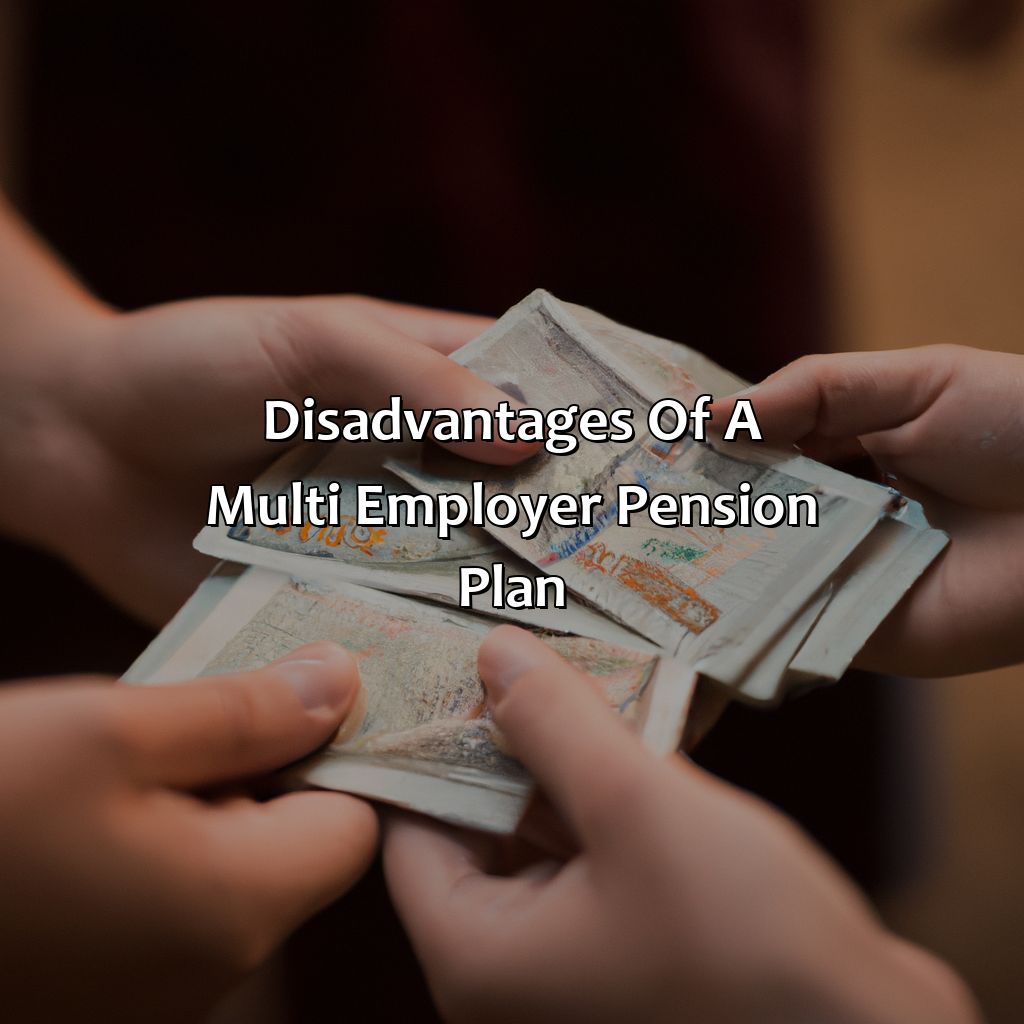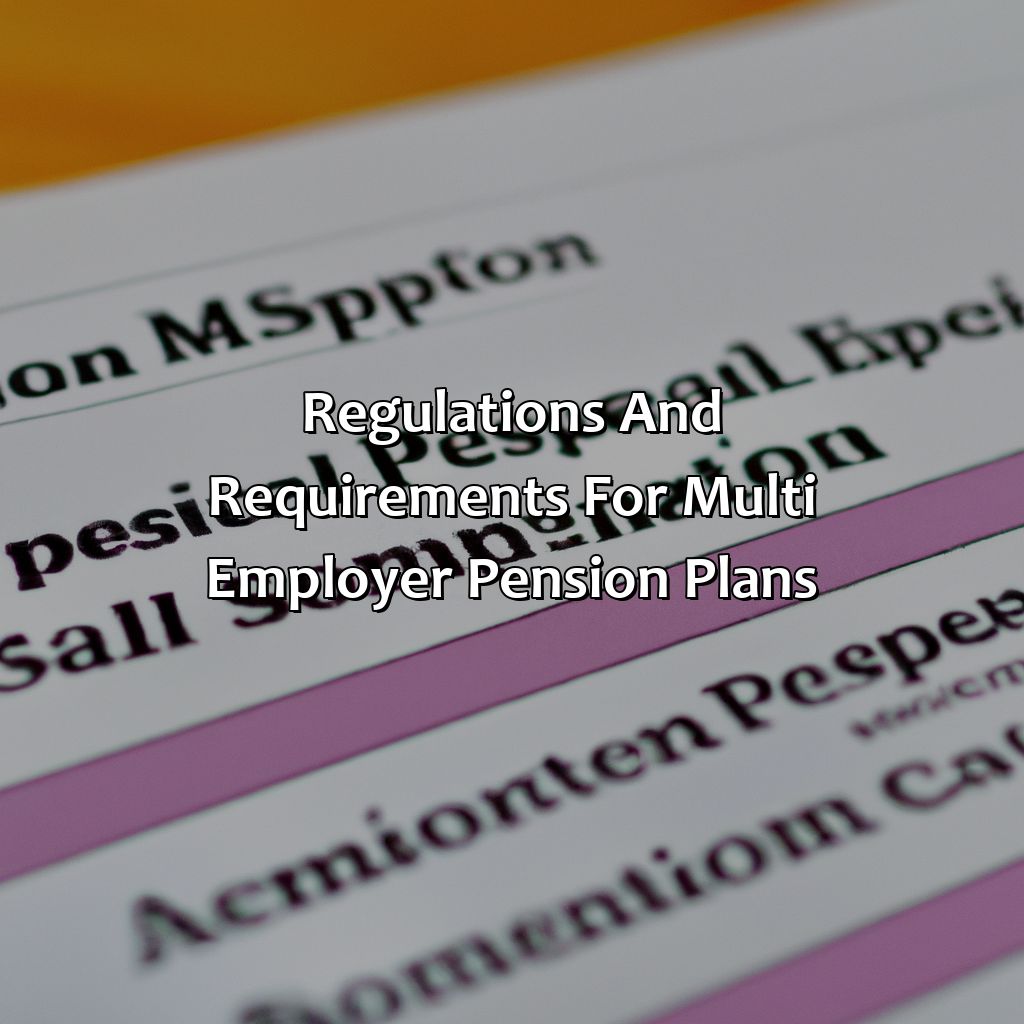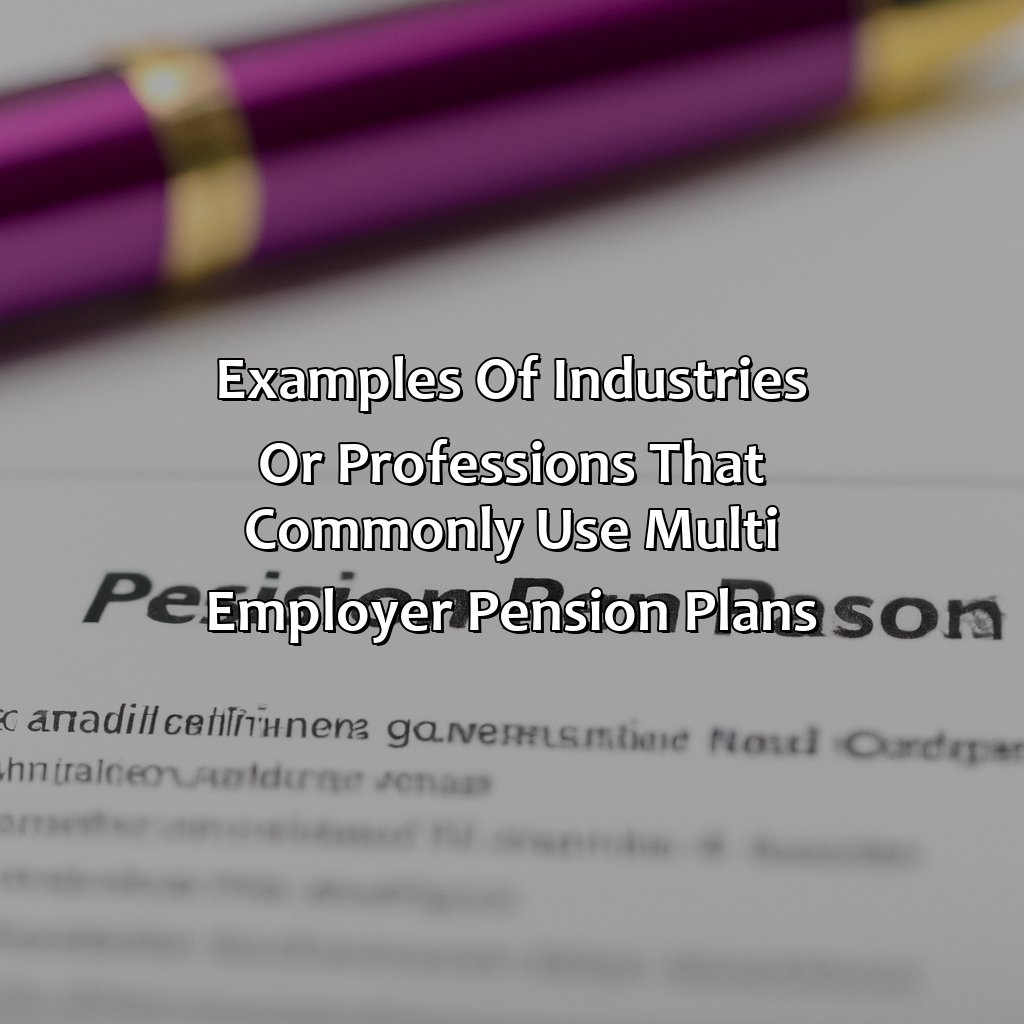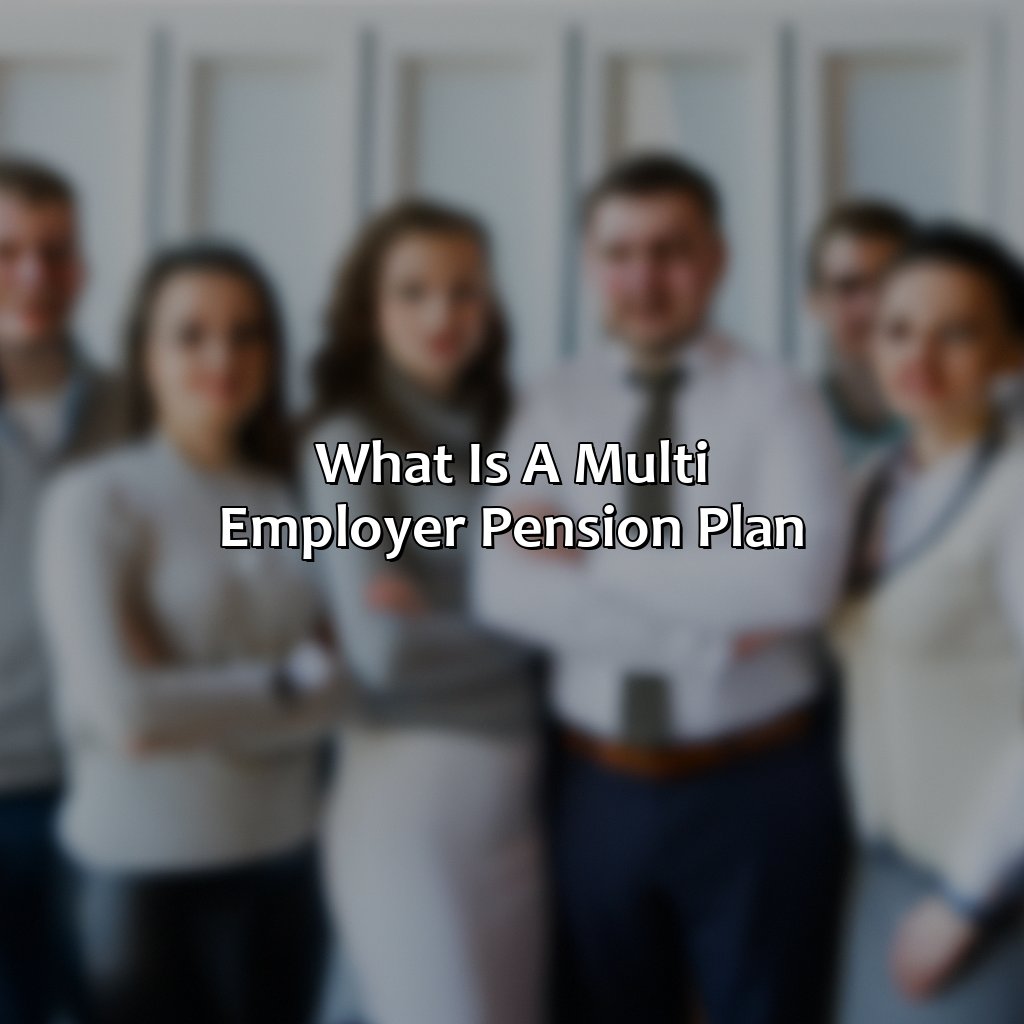What Is A Multi Employer Pension Plan?
Key Takeaway:
- A multi employer pension plan (MEPP) is a retirement plan that is shared by multiple employers, typically in the same industry or geographic area. MEPPs aim to provide retirement benefits to employees who work for different employers, but are members of the same union or industry association.
- The advantages of a MEPP include shared cost of plan administration, which allows smaller employers to access professional management of their pensions at a lower cost. MEPPs also offer larger and more diversified investment options, which can help to achieve higher returns without increasing risk.
- However, the disadvantages of a MEPP include shared financial risk among employers, which can lead to instability and even plan termination. MEPPs also offer limited flexibility in plan design, which can make it difficult to meet the unique needs of individual employers and their employees.
- MEPPs are subject to regulations and requirements set by government bodies and industry associations, such as minimum funding requirements and reporting obligations. Failure to comply with these regulations can result in penalties or plan termination.
- Industries or professions that commonly use MEPPs include construction, hospitality, healthcare, and transportation, amongst others.
Worried about how to save for your retirement? You’re not alone. A multi-employer pension plan might be the best option for you, but what is it? Read on to find out.
Definition of a multi employer pension plan
A multi-employer pension plan is a retirement plan shared by multiple employers, usually in the same industry or geographic area. This type of plan is designed to provide retirement benefits to employees who work for different employers throughout their careers. Multi-employer pension plans are typically administered by a board of trustees, who are appointed by the participating employers and employee unions. These plans are subject to government regulations and must meet certain legal requirements to ensure that they are adequately funded and provide promised benefits to participants.
Multi-employer pension plans offer several advantages, such as reduced administrative costs, as the costs are shared among multiple employers. They also typically offer more stable funding than single-employer plans, as the risks are spread across a larger group. However, there are also potential disadvantages, such as the risk of underfunding if one or more employers withdraw from the plan or go out of business.
Multi-employer pension plans are commonly used in industries such as construction, transportation, and hospitality, where employees may work for multiple employers over the course of their careers. To ensure that these plans remain viable and provide adequate retirement benefits, it is important for participating employers to make regular contributions to the plan, and for the plan trustees to closely monitor the plan’s funding and investment performance.

Image credits: retiregenz.com by Yuval Jones
Advantages of a multi employer pension plan
Uncover the benefits of a multi-employer pension plan! Dive into the shared cost of administration. Check out lower cost investment options. Investigate potential for higher returns.
By looking into these topics, you’ll understand how a multi-employer pension plan can help employers and employees. Reduced costs, increased revenues, and better plan performance are all possible.

Image credits: retiregenz.com by David Duncun
Shared cost of plan administration
Sharing the Costs of Pension Plan Administration
A pay as you go pension plan offers many advantages to both employers and employees, one of which is sharing the costs of plan administration. This means that employers share responsibility for administrative costs like record-keeping, accounting, and legal fees associated with running the pension plan.
Here’s a breakdown of how this cost-sharing works in practice:
| Employer A | $5,000 |
| Employer B | $4,000 |
| Employer C | $6,000 |
| Total Cost | $15,000 |
| Cost per employer | $5,000 |
As you can see from the table above, each employer shares an equal portion of the total administrative cost based on their number of employees enrolled in the plan.
Shared cost of plan administration frees up resources that would otherwise be spent separately by individual companies and allows smaller companies to have access to high-quality pension plans typically only available to larger companies.
Pro Tip: Collaborating with other employers through a CAAT pension plan ensures shared administrative burdens and significant potential savings overall.
Who needs fancy investment options when you can just throw a dart at the stock market and hope for the best?
Lower cost investment options
One of the benefits of being part of a multi employer pension plan is that it provides investment options at a lower cost. Here are three points to consider:
- Multi employer plans pool resources from multiple participating employers, which increases buying power and bargaining leverage with investment managers and other service providers. As a result, fees can be negotiated down and passed onto the plan participants.
- The plans typically have economies of scale because of their broad membership base, which helps in achieving lower costs per participant than what would be possible in individual or small group retirement accounts.
- Lower costs may translate into higher returns over time since more money is left invested after any fees are paid.
It is worth noting that each plan is unique, so prospective members should become well-informed about the investment options available to them before joining.
Joining a multi employer pension plan can bring incredible financial advantages to your life by reducing your expenses on investments with better returns on your savings. Missing out on such an opportunity might end up costing you more in private retirement accounts that don’t offer as many features as this type of plan does. Take action today and start securing your financial future by joining a multi employer pension plan – higher returns are just a contribution away.
Who needs a crystal ball when you have a multi employer pension plan?
Potential for higher returns
A multi employer pension plan presents a lucrative chance of earning increased returns. With the pooling of funds from multiple contributing employers, the managed funds can increase in size and scope. This makes it possible for the investment manager to select a diversified portfolio with a higher risk adjustment than standalone plans.
Moreover, larger asset pool results in lower overall fees, which further adds to this advantage. By utilizing economies of scale, trustees can afford to obtain more significant levels of support at reduced costs. Due to these factors, many multi employer pension schemes are known for their higher-than-average performance compared to traditional retirement benefits. Learn more about TPI Pension and its benefits.
Another noteworthy aspect of pension funds is their ability to mitigate some economic risks that are unique to standalone plans- such as the impact of market volatility on underfunded plans and the inability to weather sudden expense shocks effectively. Learn more about pension funds here.
Pro Tip: Consider diversifying your pension plan by investing in multiple employers’ pooled assets through multi employer pension plans for higher returns and lower expenses. If you think having multiple partners is complicated, try managing a multi employer pension plan.
Disadvantages of a multi employer pension plan
To grasp the disadvantages of a multi-employer pension plan, you need to comprehend the potential problems. Financial risk is shared among employers, which can cause unsteadiness. Plan design has little flexibility, meaning less personalization for certain needs. The possibility of plan termination also lingers.
Let’s delve further into these three sections.

Image credits: retiregenz.com by Adam Duncun
Financial risk shared among employers
A multi employer pension plan distributes financial risk among employers who contribute to a common retirement fund. Employers benefit from pooling assets, providing economies of scale, and minimizing administrative costs. However, the plan has disadvantages as well. Low funded ratios or insufficient contributions by some of the participating employers can lead to financial instability and shortfalls in the fund. In extreme cases, defaulted contributions may result in loss of plan coverage for affected pension recipients. These risks may be mitigated through careful selection and monitoring of contributing employers.
According to Forbes, multi employer pension plans are currently underfunded with a deficit of over $673 billion in 2020 in the US alone.
Looks like the multi employer pension plan forgot to add flexibility to its retirement workout routine.
Limited flexibility in plan design
A multi employer pension plan provides a limited level of flexibility in terms of plan design. This means that the structure and rules of the plan must remain uniform for all participating employers, regardless of their specific needs or preferences.
The limitation on flexibility can be disadvantageous for certain employers who may want to customize their retirement plans. For example, if one employer wants to have more generous contribution limits than what is allowed by the plan, they cannot do so under a multi-employer pension plan.
Other limitations can include restrictions on investment options and administrative fees shared amongst all participating employers. These can lead to reduced control over investment decisions and higher costs for some employers.
If you want to know more about retirement pension, specifically Category A State Retirement Pension, click here.
It is vital to understand that such plans may put constraints on businesses, limiting them from receiving the benefits that they desire. According to a report by Pension Rights Center in Washington DC, it is essential to carry detailed research before deciding upon such plans as they bring about several disadvantages along with benefits. If you’re curious about what is pension scheme, it’s important to note that multi employer pension plans fall under this category.
The only thing more unpredictable than the stock market is the possibility of your multi employer pension plan disappearing faster than a magician’s assistant.
Possibility of plan termination
A multi-employer pension plan is vulnerable to termination due to financial instability or insolvency of the employers in the plan. This possibility can become a major drawback for employees that have been relying on the pension plans for their retirement income.
In some cases, when one employer terminates its participation in the plan, it affects other employed participants adversely by causing increased liability and expenses. Moreover, if a significant number of employers withdraws from the plan simultaneously or declares bankruptcy, the chances of fund depletion escalate. The retirement benefits promised then become uncertain leading to stress and anxiety among employees.
One possible solution to prevent plan termination could be diversification of investments within retirement funds across different avenues such as with stocks, real estate, and corporate bonds. Another approach is creating reserve funds to prevent depletion in case a large employer decides to leave. To learn more about retirement plans, check out our article on money purchase pension plans.
These measures will not only ensure stability but also provide sufficient liquidity when required. Investment decisions should be well-planned and not cause sudden shocks in value or cash flow fluctuations. Educating employees about occupational pension plans and investment decisions can also enhance their understanding of their plans and give them confidence in managing their retirements efficiently.
Looks like multi-employer pension plans have more rules than my mom’s house growing up.
Regulations and requirements for multi employer pension plans
Multi employer pension plans are subject to certain rules and regulations that must be followed. These regulations ensure that employers adequately fund their employees’ retirement accounts, and protect the plan participants’ rights and interests. Below is a table summarizing some of the key regulations and requirements for multi employer pension plans:
| Regulation/Requirement | Description |
|---|---|
| Minimum Funding Standards | Plans must follow IRS and DOL regulations to ensure that they have enough money to pay benefits. |
| Plan Documents | Plans must have written documents outlining the plan’s terms and conditions, and distributing this information to participants. |
| Vesting Schedule | Plans are required to follow regulations specifying how long employees must work to become vested. |
| Non-Discrimination Rules | Plans must be designed to benefit all employees, and cannot unfairly prioritize certain groups. |
| Reporting and Disclosure Requirements | Plans must file annual reports to the federal government and distribution periodic notices to participants, informing them of their rights and benefits. |
In addition, multi employer pension plans are required to adhere to certain unique requirements, specific to their type of plan. It is important for plan sponsors to work closely with their plan administrator to ensure that all requirements are met.
To ensure compliance with these regulations and requirements, it is recommended that plan sponsors regularly review their plan documents and seek guidance from a qualified professional.
By following these rules, multi employer pension plans can effectively provide employees with a secure and sustainable retirement benefit.

Image credits: retiregenz.com by Joel Duncun
Examples of industries or professions that commonly use multi employer pension plans
Multi employer pension plans are commonly used in various industries and professions, allowing employees to receive pension benefits from multiple employers. Here are some examples of industries or professions that commonly use such plans:
- Construction industry
- Healthcare industry
- Transportation industry
- Hospitality industry
- Retail industry
In addition to these, multi employer pension plans are also prevalent in industries with seasonal or temporary employment, such as agriculture, entertainment and hospitality. These plans provide flexibility and security for employees who work in these industries.
It’s important to note that not all multi employer pension plans are equal, and some may offer different benefits or have different eligibility requirements. Employees should carefully review their options and choose a SERP pension plan that best suits their needs.
To optimize retirement savings, employees can consider contributing to an individual retirement account (IRA) in addition to their multi employer pension plan. This can help diversify their retirement savings and provide additional financial security. Employers can also consider offering financial wellness programs to their employees, providing resources and education on retirement planning and other financial topics.

Image credits: retiregenz.com by James Washington
5 Well-Known Facts About Multi Employer Pension Plans:
A multi employer pension plan (MEPP) is a type of pension plan that covers multiple employers and their employees. (Source: Investopedia)
MEPPs are often used by companies in industries with high turnover rates, such as construction and hospitality. (Source: The Balance)
MEPPs are governed by both federal and state laws, and are required to meet specific funding and reporting requirements. (Source: Pension Benefit Guaranty Corporation)
MEPPs can be either defined benefit plans, which guarantee a specific retirement benefit, or defined contribution plans, which set aside contributions but do not guarantee a specific benefit amount. (Source: IRS)
MEPPs are regulated by the Employee Retirement Income Security Act (ERISA), which sets standards for reporting, disclosure, and fiduciary responsibility. (Source: Department of Labor)
FAQs about What Is A Multi Employer Pension Plan?
What is a multi employer pension plan?
A multi employer pension plan is a type of retirement plan that is organized by a group of employers who are generally in the same industry or geographic location and have a union or employee association in common. The plan covers the employees of all participating employers, with each employer generally contributing a set amount to the plan based on the number of employees it has in the plan.
How do multi employer pension plans work?
Multi employer pension plans work by pooling the resources of multiple employers to provide retirement benefits to their employees. The plan is jointly administered by a board of trustees that is generally made up of representatives of the participating employers and the union or employee association. These trustees are responsible for investing the assets of the plan and ensuring that it remains fully funded.
What are the advantages of a multi employer pension plan?
One of the main advantages of a multi employer pension plan is that it allows small employers to offer retirement benefits to their employees that are typically only available to larger employers. Additionally, since the plan is jointly administered by representatives of the participating employers and the union or employee association, it tends to be more stable and well-funded than other types of retirement plans.
What are the disadvantages of a multi employer pension plan?
One of the main disadvantages of a multi employer pension plan is that if one or more employers withdraw from the plan, the remaining employers may be required to make up any shortfall in funding. Additionally, if the plan experiences significant investment losses or other financial problems, it may become necessary to reduce or suspend benefits for current and future retirees.
How are multi employer pension plans regulated?
Multi employer pension plans are regulated by the Employee Retirement Income Security Act (ERISA), which sets minimum standards for plan funding, vesting, and participation. Additionally, the plan must comply with any applicable state and federal regulations, such as tax laws and securities laws.
What happens to my retirement benefits if my employer withdraws from the multi employer pension plan?
If your employer withdraws from the multi employer pension plan, your retirement benefits may be affected. Depending on the terms of the plan and the reason for your employer’s withdrawal, you may be entitled to receive a portion of the benefits that you have accrued so far. However, if the plan is underfunded, your benefits may be reduced or delayed, and you may not receive the full amount that you were expecting.
 Checkout this IRS Loophole
Checkout this IRS Loophole 
